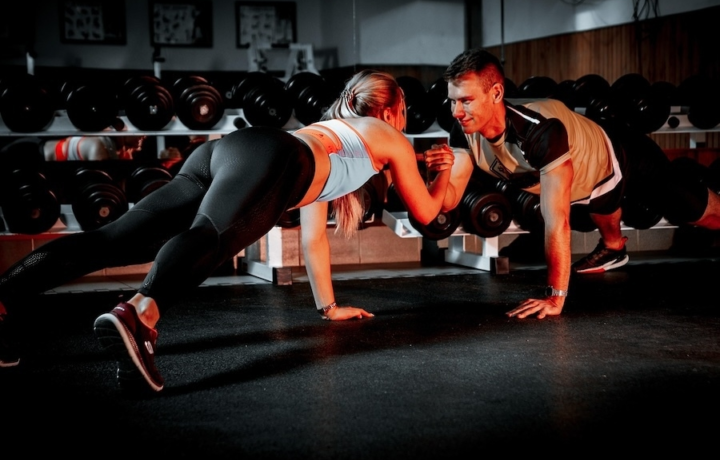Exercise
Barbell Wrist Reverse Curl

Barbell Wrist Reverse Curl
How to Perform
- Stand holding a barbell with an overhand grip (palms facing down), hands shoulder-width apart and arms extended downward in front of your thighs.
- Keep your upper arms stationary against your sides with elbows flexed at approximately 90 degrees throughout the movement.
- Establish a stable base with feet shoulder-width apart and maintain a neutral spine position with shoulders pulled back slightly.
- Inhale before initiating the movement, bracing your core to maintain stability throughout the exercise.
- Exhale as you curl the weight upward by flexing your wrists, moving only your hands and keeping your forearms stationary.
- Continue curling until your knuckles are pointed toward the ceiling and you feel a complete contraction in your forearms.
- Hold the contracted position briefly at the top of the movement, focusing on the tension in your forearm extensors.
- Inhale as you slowly lower the barbell back to the starting position by extending your wrists in a controlled manner.
Important information
- Start with a lighter weight than you'd use for standard curls, as forearm extensors are typically weaker than flexors.
- Keep your movements slow and controlled to prevent momentum from taking over the exercise.
- Make sure your elbows remain fixed at your sides throughout the entire movement to isolate the forearm muscles properly.
- If you experience wrist pain rather than muscle fatigue, consider using a lighter weight or checking your form with a trainer.

Barbell Wrist Reverse Curl
Exercise Details
Primary Muscles
Muscle Groups
Mechanic
Risk Areas
Built for progress
Take the guesswork out of training
Create personalized AI-powered workout plans that evolve with you. Train smarter, track every rep and keep moving forward, one workout at a time.






The Barbell Wrist Reverse Curl stands as one of the most effective isolation exercises for developing impressive forearm strength and definition. This intermediate-level movement specifically targets the extensor muscles on the top of the forearms – an area often neglected in standard training programs but crucial for balanced arm development and overall grip capability.
Unlike traditional curls that focus on the flexor muscles, reverse curls shift the emphasis to the extensors, creating that coveted muscular balance that both competitive bodybuilders and strength athletes pursue. The exercise's beauty lies in its simplicity, requiring only a barbell, yet it delivers remarkable results when performed consistently within a well-structured training regimen.
For bodybuilders, the reverse curl isn't merely about aesthetics – though it certainly contributes to that coveted vascular, striated forearm appearance. This movement enhances wrist stability and control, translating to improved performance across various pressing and pulling exercises. The increased forearm strength from regular reverse curl training can be the difference between grinding out those final heavy deadlift repetitions or failing to maintain your grip.
Strength athletes particularly value this exercise for its carryover to functional power. Strong forearm extensors balance the typically dominant flexors, potentially reducing the risk of imbalance-related injuries while supporting heavier lifts in compound movements. The wrist control developed through reverse curls proves invaluable in sports requiring precise hand positioning or resistance against opposing forces.
When integrated into a comprehensive arm routine, the barbell wrist reverse curl serves as the perfect finishing movement, ensuring complete forearm development. While it may not be as glamorous as bicep curls or as impressive as heavy bench presses, this exercise's contribution to upper body strength and aesthetics is undeniable. For those serious about maximizing forearm development and enhancing overall grip strength, the barbell wrist reverse curl deserves a permanent place in your training arsenal.
FAQ - Barbell Wrist Reverse Curl
The barbell wrist reverse curl primarily targets the extensor muscles on the top of your forearms, including the extensor carpi radialis and extensor digitorum. This exercise complements traditional curls by developing the often-neglected antagonist muscles to your flexors, creating balanced forearm development.
Start with significantly less weight than you would use for standard curls—typically 30-50% less. These extensor muscles are naturally weaker than your flexors, and using too much weight will compromise form and reduce effectiveness. Focus on controlled movement rather than heavy loading.
Incorporate barbell wrist reverse curls 2-3 times weekly with at least 48 hours between sessions to allow for adequate recovery. You can perform 3-4 sets of 10-15 reps, either as part of your arm workout or at the end of pulling sessions for maximum forearm development.
The three most critical errors are allowing the hips to sag (losing the pike position), shoulders rolling forward (compromising joint safety), and excessive body wobbling due to poor core bracing. Focus on maintaining a straight line from hands to hips, keeping shoulders packed away from ears, and engaging your core throughout the movement.
To increase difficulty, try implementing slower negatives (3-4 second lowering phase), add partial holds at the top of each rep for 2-3 seconds, or progress to an EZ-bar or straight barbell once you've mastered the movement with a lighter bar. Advanced lifters can also experiment with drop sets to thoroughly fatigue the forearm extensors.






